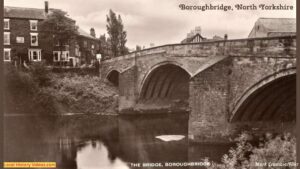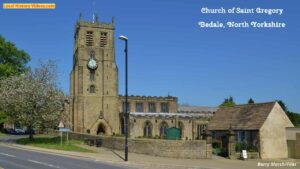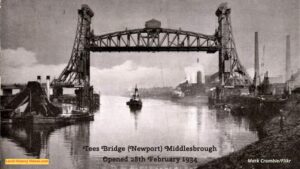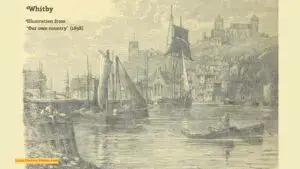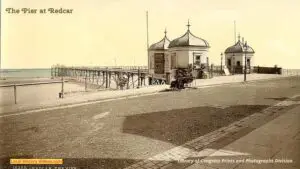Helmsley is a well-known market town in North Yorkshire. It’s popular with tourists today because of the castle ruins, but the fortifications saved many lives in the past.
Helmsley In Anglo-Saxon Times
What does Helmsley mean? Helmsley derives from Helm’s Clearing. It suggests the area was home to an Anglo-Saxon farm.
Previously the area was under Roman occupation. The nearest known Roman habitation is a couple of miles away near Beadlam Grange. The remains of a fourth-century Roman villa, including a fine mosaic pavement, have been unearthed there.
Folklore has it that when St Aiden preached at ‘Hamlake’ during the seventh century, it was referring to Helmsley.
▶ YouTube channel Spirit in Stone has a five-minute film introducing St Aiden and his known life in the early Christian monasteries.
All Saints Church in Helmsley underwent a restoration in 1868. Three square stones with square holes in them were found. At the time people concluded that they were foundation stones to support the posts of a Saxon wattle church.
Helmsley Appears In The Domesday Book
Helmsley appears in the Domesday Book, which was completed in 1086 by the order of King William the Conqueror. At the time, the Normans called the village Elmeslac. 13 families, two priests and a wooden church were found by the auditors.
▶ The Domesday Book | The Story of Britain | BBC Teach is a short, easy-to-watch video quickly summarising the reasons for the Domesday Book. While it is aimed at 7-11-year-olds, it contains a lot of information that’s unknown to the average British resident today.
In total, the village of Helmsley had 11.5 carucates. Each carucate was an area of land that a team of eight oxen could plough in one year. So it’s open to interpretation how much land the Domesday village cultivated. Estimates settle at between 160 and 180 acres.
At the time, the area’s lands belonged to Robert de Mortain, gifted by his half-brother William I. But when he rebelled against William Rufus in 1088, they were ultimately transferred to Walter l’Espec.
The Expansion of Helmsley
As Lord of Helmsley from 1120 to 1154, l’Espec oversaw a significant expansion of Helmsley village, the establishment of Rievaulx Abbey, and the raising of the first Helmsley Castle. This last decision may have been in response to the 1138 Battle of the Standard against the Scots, which occurred just a few miles west of the village.
The New Castle At Helmsley
Walter l’Espec did not have children, so on his death, his estate passed to his brother-in-law, Robert de Ros.
Robert de Ros obliterated the original castle with a new and vast replacement. Measuring 250 yards by 150 yards, it also boasted ditches, ramparts, turrets, high stonework, a defended portcullis with a drawbridge, and the Helmsley keep.
Further extension of the castle came about 50 years later. A barbican was constructed between the two ditches. And even that was later altered, to provide basic accommodation to the outer garrison.
The late addition of a chapel next to the keep would not have been popular with the local church, who lost both worshippers and their donations.
Helmsley Castle Under Siege And Attack
Robert de Ros was one of the twenty-five barons who co-signed the Magna Carta at Runnymede in 1215. But neither side to the agreement stood behind their commitments, and in 1216 the castle was besieged by King John who ultimately forced Robert to give up Carlisle Castle.
The castle was more briefly besieged by the Scots in 1322. They left after looting and burning the village.
The only time the castle was fully attacked by an army was during the English Civil War of 1642-1651. The Royalists, under Sir Jordan Crossland, held the castle for its owner, the Duke of Buckingham. But the Parliamentarians brought in cannons, which did not exist when castles were built. Despite that, it took three months for the Royalists to surrender. Even then, only the defeat of a relief column forced the surrender
▶ If you want to see a modern-day recreation of this event, Oliver Parr has a 13-minute video on YouTube called The Siege Of Helmsley Castle.
▶ Composer Richard G. Mitchell wrote the music score for the film To Kill A King. You can hear a 3-minute excerpt of the music accompanied by a clip from the film on his YouTube video TO KILL A KING “Roundheads storm Parliament & Holles escapes”.
The Demise Of Helmsley Castle
The attack on the castle had been led by Sir Thomas Fairfax. Cromwell rewarded him with ownership of the castle and estate.
Thirteen years later, Fairfax’s daughter married Buckingham’s son. They were keen to erase the castle’s history, so they allowed its destruction in a variety of ways. The locals, for example, were more than happy to take what they could use once given permission to do so.
Luckily, enough of the castle has remained to provide an interesting destination for tourists today.
▶ Matthew Dyson Media filmed Helmsley Castle for BBC News at Six. They used drone footage to give a clear picture of the current remains of the castle.
More about North Yorkshire
- Boroughbridge, North Yorkshire: History in Old Images
- Bedale, North Yorkshire: History in Old Images
- Ripon, North Yorkshire: History in Old Images
- Old Images of Middlesbrough
- Old Images of Whitby, Yorkshire
- Old Images of Redcar, North Yorkshire
.
Thanks to Emphyrio for the image at the top of this page.


